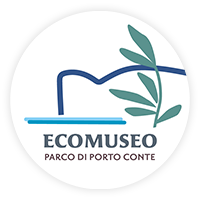The Villa Romana
The Roman Villa of Sant'Imbenia is a seaside villa, used by the Romans as a place of rest and "vacation". This type of residence, widespread throughout the Mediterranean, was characterized by great refinement and luxury; very often, the main part was accompanied by a part called "rustic", destined for agricultural production, with related activities, such as the production of ceramics and tableware for transporting products, tools for work etc.
The Villa of Sant'Imbenia, built between the end of the 1st century BC and the beginning of the 1st century AD, with various modifications, was used until the 4th century AD.The continuity in the settlement is in itself an interesting feature, as it denotes the vitality of that area over at least four centuries. The villa consisted of two floors, a bath area, a sea-facing area with dining rooms, rest rooms, and service areas. There was therefore a large area dedicated to production. It is highly likely that there were also tanks for sea fish farming, according to a common practice, for example, in seaside villas in the Lazio and Campania regions. The villa was particularly rich: it was built with marbles from all over the Mediterranean, Asia Minor, Egypt, Greece, Italy; the stuccos are of great value, and the ceiling, in particular, presents a very refined technique, with very rare octagonal decorations.
The part that is now visible, the subject of excavations that have produced much material, includes a part of the main area facing the bay. The second floor, collapsing, protected the lower floor, preserving rooms with remains of highly prized stucco work (now kept in the Archaeological Museum of the city of Alghero, but also visible in some walls), marbles, mosaic floors. The baths have been identified, which gave the villa the character of a high-quality residence, and some rooms were probably intended for rest and reading, in addition to a room that was probably used for lunch. These rooms looked directly out to sea, a few meters away; this served to improve ventilation and enjoy an extraordinary view. The rustic part has not yet been excavated, but only partially identified.
Everything suggests that the villa was built by a character who was not only rich, but also belonged to the governing aristocracy, a senator or a high official, or even the governor of the province himself. In fact, procuring precious materials, such as marbles, which were the property of the emperor, transporting them, finding skilled craftsmen, implied proximity to power that only facilitated these operations. There is no doubt that the foundation of the Roman colony of Turris Libisonis (Porto Torres) deeply modified the structure of this part of Sardinia; the port, the presence of Roman citizen colonists owning the lots of land assigned to them, the cultivation of the city's territory, the proximity of the mines, all contributed to making it attractive for a wealthy Roman to build a pleasurable and productive residence.
Informations
TICKET
Are you interested?
If you want to purchase a product, book an excursion or receive more information on the park and its facilities, don’t hesitate to get in touch.
We are ready, willing and able to help!




